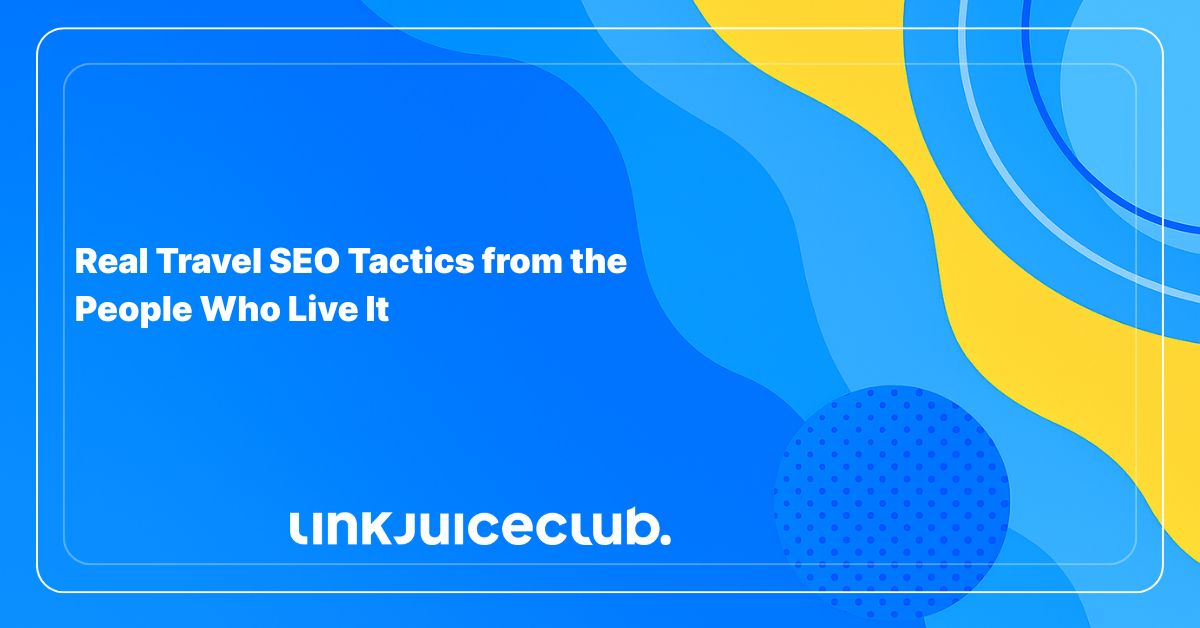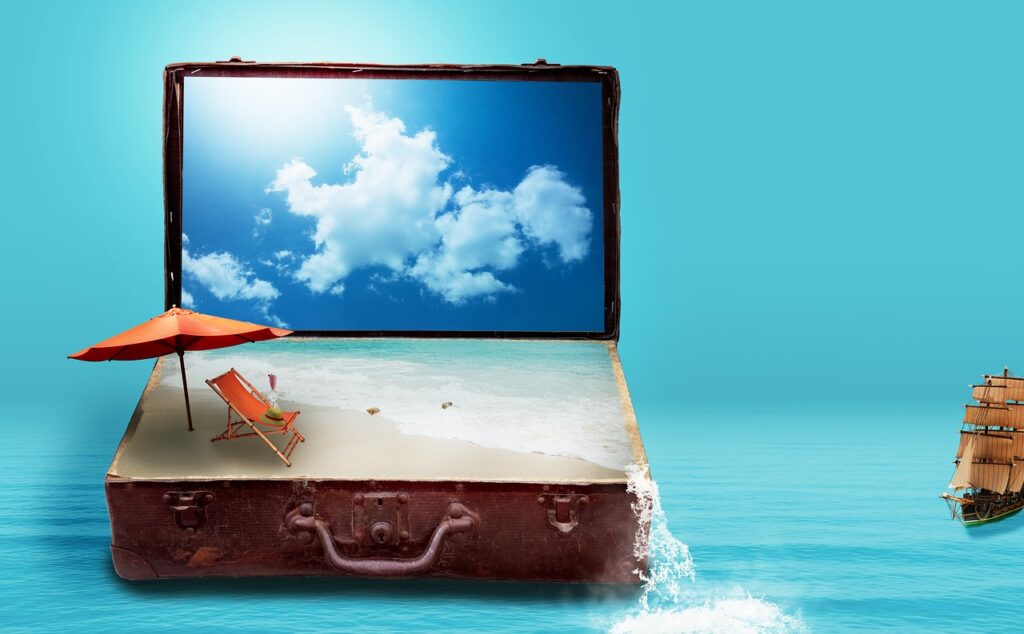
Real Travel SEO Tactics from the People Who Live It
Sure, social media might spark the travel bug. But when it’s time to book that flight, compare destinations, or read a review about that suspiciously cheap hostel in Berlin, everyone heads to Google.
That’s where travel SEO becomes the real MVP.
This space isn’t just crowded; it’s a digital jungle. You’re not just up against other tour operators or hotels. You’re up against Booking.com, TripAdvisor, and Google itself, which now happily ranks its own travel features above yours.
If that sounds like chaos, you’re not wrong. But there is a method to the madness. Real travel publishers and SEOs have figured out how to carve out visibility in this brutal space.
So buckle up. This is your travel SEO survival guide. ✈️
Why Travel SEO Is Tougher Than It Looks
Travel SEO isn’t your standard keyword-and-backlink operation. It’s way more complex… way more.
Basically, you need to juggle a dozen industries at once. Just think about all the hotels, airlines, travel insurance, tour operators, travel tech, blogs, and comparison sites… all fighting for space in the same search results.

And if that wasn’t enough, travel demand changes constantly. Seasonality, weather issues, natural disasters, even world events, anything can throw your rankings into a tailspin overnight.
1. Stop Chasing Volume, Start Chasing Bookings
If your travel site is still trying to rank for terms like best hotels in Rome or things to do in Paris, you’re probably just feeding Google’s AI Overviews.
That’s why smart travel businesses are going for keywords that actually lead to bookings. We’re talking terms that show clear intent. Like, instead of targeting london tour, a local operator would have a much better shot (and better ROI) going after jack the ripper night walking tour soho or hidden pubs tour london bridge.
Even if the search volume is low, the conversion potential is sky-high. People typing in those kinds of keywords are either packing their bags or already standing in the city center looking for something cool to do. And guess what? These keywords are usually way easier to rank for. No need to go head-to-head with Expedia.
2. Build Links by Making Headlines, Not Just Blog Posts
Backlinks still matter. But in the travel space? Good luck getting other sites to link directly to your tour page or booking form. It’s tough, saturated, and everyone’s already done the Ultimate Guide to Barcelona twenty times over.
So how do you get high-authority links? You stop thinking like a blogger and start thinking like a PR team. That’s what smart travel brands are doing, using digital PR to get real media coverage.
No, you don’t need to be a data scientist. You just need something interesting to say. Use your booking data if you’ve got it, or pull from third-party sources and spin up a story people care about. Trends, travel habits, cost-of-living comparisons, find a hook.
Make it easy for journalists. Give them angles. The big outlets want national narratives, while local ones will happily highlight that their city made the list. The more angles you offer, the more chances your content gets picked up.
3. Create Content That Moves With the Moment
You know what gets clicks faster than a generic city guide? Content that rides the wave of what’s happening right now. Let’s say a new art biennale opens in Bilbao or there’s a viral hiking challenge trending on TikTok through the Scottish Highlands
Suddenly, people aren’t just searching Spain or Scotland. They’re looking up how to get there, where to stay, what to do, and how to be part of the moment. Tools like Google Trends or just paying attention to regional event calendars will tell you what’s about to pop.
You don’t need to go viral to go relevant. Maybe your city is hosting a tattoo convention or a cheese festival (yes, that’s a thing). If people are traveling for it, travel SEO should be part of your content plan. Write guides, make maps, and highlight nearby experiences!
4. Ditch the Obvious Destinations (and Win in the Gaps)
Everyone has written about things to do in Rome. But have you tried targeting hidden beaches near Puglia or best day trips from Ghent? That’s where travel SEO actually gives smaller players a shot.
You don’t need to be based in a sleepy village to talk about one. A Berlin-based bike tour company could write about a weekend guide to Leipzig. A Croatia sailing operator could publish a piece on less-crowded islands that connect back to their own routes. Think like a traveler, not just a keyword hunter.
5. Build Clusters That Mirror Real Travel Plans
Topic clusters aren’t just a nerdy travel SEO structure.They’re a practical way to guide travelers from the daydream stage to passport in hand. Think like a traveler: what would someone need to know before heading off on a trip to, say, Patagonia?
Create a hub that walks them through the full planning cycle. From Best Time to Visit Patagonia to Top Glacier Hikes to Packing Checklist for Windy Weather. Link these articles together so readers (and Google) know your site is the complete package.
Want to go further? Build clusters around travel styles, not just destinations: eco-travel in Scandinavia, culinary adventures through Georgia (the country!), or budget island-hopping in the Philippines.
6. Write Like You’ve Actually Been There
Google loves real-deal experience, and so do readers. If your post on hiking in Madeira reads like a brochure and not like someone who nearly got chased by a goat in the fog, you’ve missed the mark.
Been somewhere? Great. Share what the map won’t tell you: that the bus to the cliffs runs late, or that the hidden beach now has a smoothie bar.
Can’t visit personally? Hire writers who’ve walked the walk, not just Googled it. And yes: ask for photos, pepper in personal tips, and don’t be afraid to share the weird, the awkward, and the not-so-perfect. That’s what makes it real.
6. Don’t Let a Slow Site Sink Your Travel SEO
Travel websites love showing off with big, bold photos and fancy maps, but all that eye candy comes at a cost. If your page takes forever to load, visitors will go somewhere else fast.
Here’s how to keep things quick: shrink those giant images, delay loading videos until people scroll to them, and ditch any plugins you don’t really need. Your site should feel smooth, even on a dodgy hotel Wi-Fi connection.
Not sure what’s slowing you down? Run a site audit and check your Core Web Vitals. Fix whatever’s clunky. A fast site means happier visitors, better rankings, and more bookings. Simple as that.
Travel SEO That Actually Goes the Distance
In travel SEO, there’s no room for generic strategies or half-baked content. Everything you publish needs to serve a purpose, and ideally, a plane ticket! ✈️
The travel niche is wild, competitive, and constantly evolving, so you need the right tactics (the ones you read about above).
Travel SEO is wholly about guiding real people on real journeys. And that’s exactly where your site should shine.





